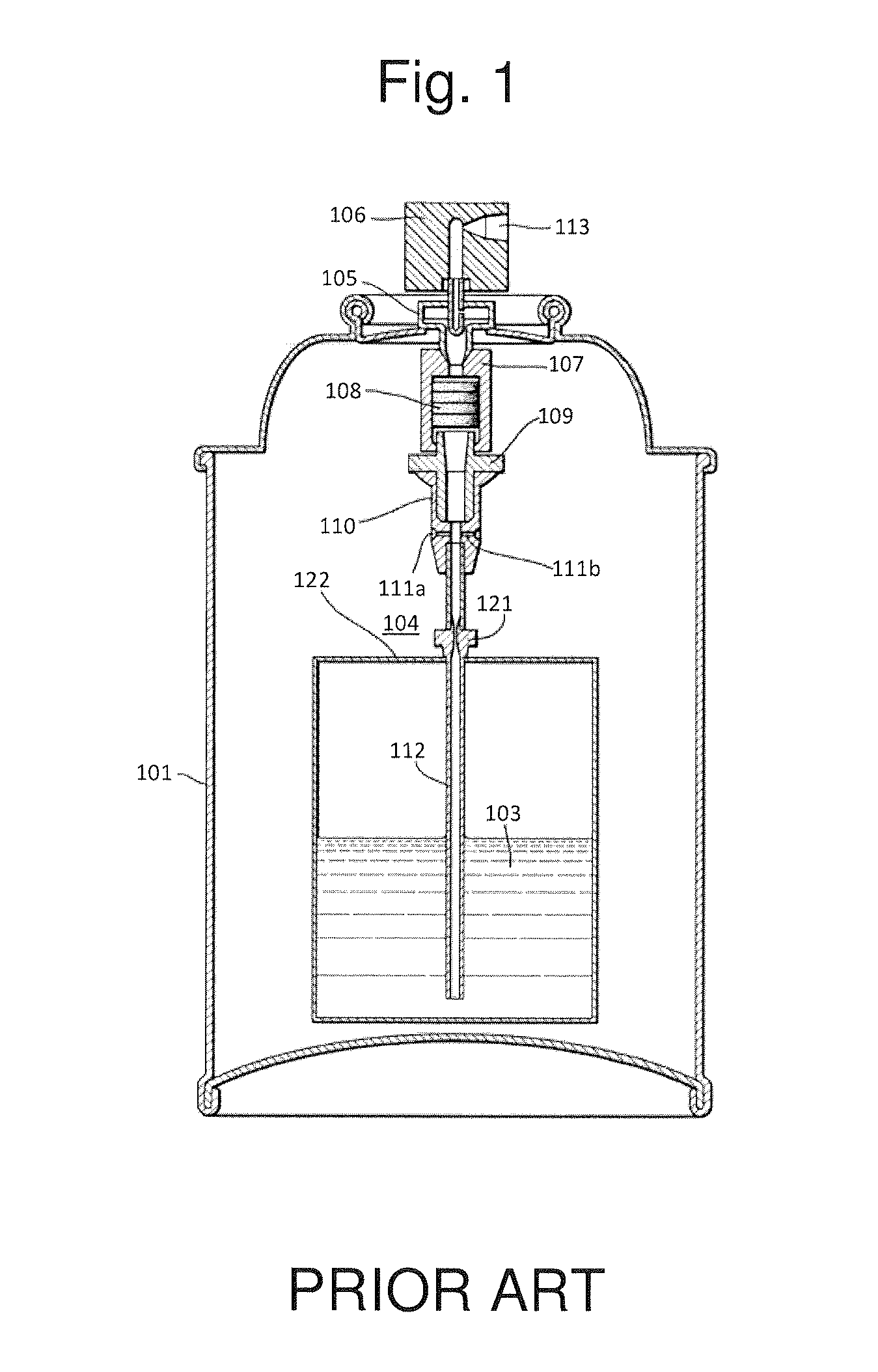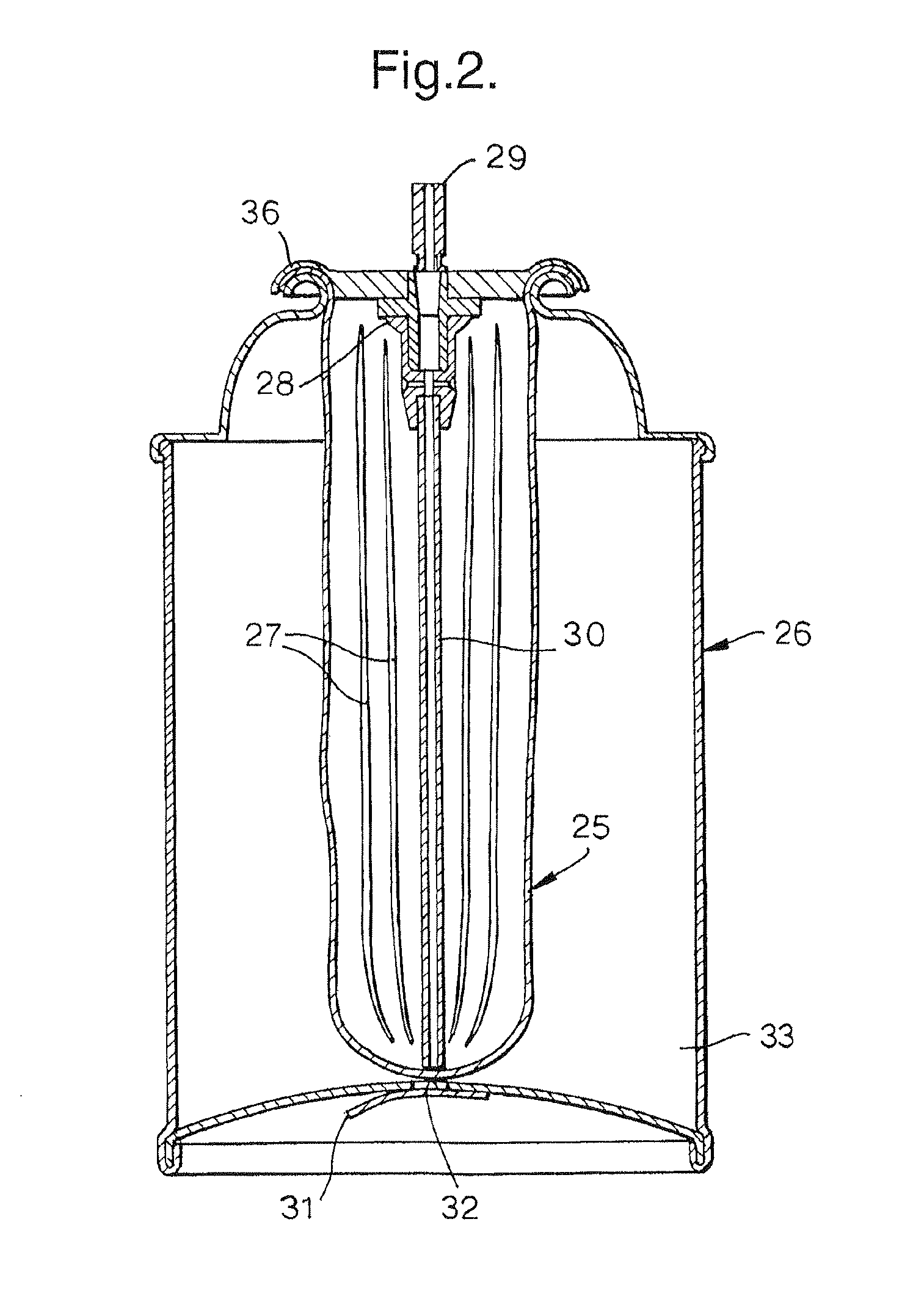Container for the generation of therapeutic microfoam
a technology of microfoam and container, which is applied in the field of container for the generation of therapeutic microfoam, can solve the problems of ineffective concentration of sclerosant at the concentration required to limit the dosage to safe levels, the inapplicability of the inability to apply sclerotherapy to large varicose veins. , to achieve the effect of diffusion through the alveolar
- Summary
- Abstract
- Description
- Claims
- Application Information
AI Technical Summary
Benefits of technology
Problems solved by technology
Method used
Image
Examples
example 1
“Bag-in-can” Device
[0079]A first embodiment of the present invention is shown in FIG. 2. The device uses a standard bag-in-can construction of the type supplied by US Can Corporation of Lombard, Ill., or Crown Cork & Seal Company Inc. of Philadelphia, Pa. The bag (25), typically composed of blow moulded nylon 6,6 or HDPE, but not limited to these polymers, and of an inflated size ideally equal to or greater than the internal volume of the canister, is inserted into the can (26) through the open mouth of the canister. A number of axial pleats (27) in the bag wall (25) aid in easy insertion of the bag through the open mouth of the can. A mixing valve (28) (e.g. Ecosol™ type, Precision Valve, Peterborough, UK) is crimped onto the can, trapping the mouth of the bag in the valve crimp (36) and effecting a seal.
[0080]A vacuum pump is attached to the stem valve outlet (29) of the sealed can, the valve is depressed to open a pathway to the bag interior, and a vacuum drawn inside the bag to ...
example 2
“Bag-on-Valve” Device
[0084]A further embodiment of the present invention is shown in FIG. 4, which is broadly similar in operation to Example 1, though incorporating a “bag-on-valve” device. FIG. 4 shows the device in its unfilled state. Such bags are normally constructed from a tri-layer laminate comprising a heat sealable material on the inner surface (PVdC or similar), an aluminium foil as the centre layer, and a tough plastic for the outer layer (PET, Nylon 6,6 or similar). The bags are normally supplied coiled or furled around the central long axis by companies such as Coster Aerosols Ltd., Stevenage, UK, and normally contain a dip tube (30). To keep them tightly furled, it is normal practice to employ a number of adhesive tape tabs (34) that are based on a weak paper backing. When the bag (25) is subsequently inflated, these tabs tear and allow the bag to fill almost the entire volume of the canister (26). In this example, it is critical that the weld between the bag and the v...
example 3
Container with Engaging Means and Mesh Stack Shuttle
[0086]A device comprising a container provided with engaging means and a mesh stack shuttle according to the invention, as disclosed in the co-pending application WO 02 / 41872-A1, is shown in FIG. 6. The device comprises a container (1) for an aqueous sclerosant liquid, a container (2) for a physiologically acceptable blood-dispersible gas and an engaging means comprising a connector (3).
[0087]The container (1) for the aqueous sclerosant liquid is pressurised to a level of 0.5 bar absolute. The container (2) for a physiologically acceptable blood-dispersible gas is charged with pure oxygen gas at 5.8 bar absolute pressure. Container (2) is used to pressurise the container (1) for the aqueous sclerosant liquid just before the microfoam is required, and is then discarded. The two containers will thus be referred to hereinafter as the PD [polidocanol] can (1) and the O2 can (2). In this example each of the containers (1,2) has approxim...
PUM
| Property | Measurement | Unit |
|---|---|---|
| Length | aaaaa | aaaaa |
| Length | aaaaa | aaaaa |
| Density | aaaaa | aaaaa |
Abstract
Description
Claims
Application Information
 Login to view more
Login to view more - R&D Engineer
- R&D Manager
- IP Professional
- Industry Leading Data Capabilities
- Powerful AI technology
- Patent DNA Extraction
Browse by: Latest US Patents, China's latest patents, Technical Efficacy Thesaurus, Application Domain, Technology Topic.
© 2024 PatSnap. All rights reserved.Legal|Privacy policy|Modern Slavery Act Transparency Statement|Sitemap



